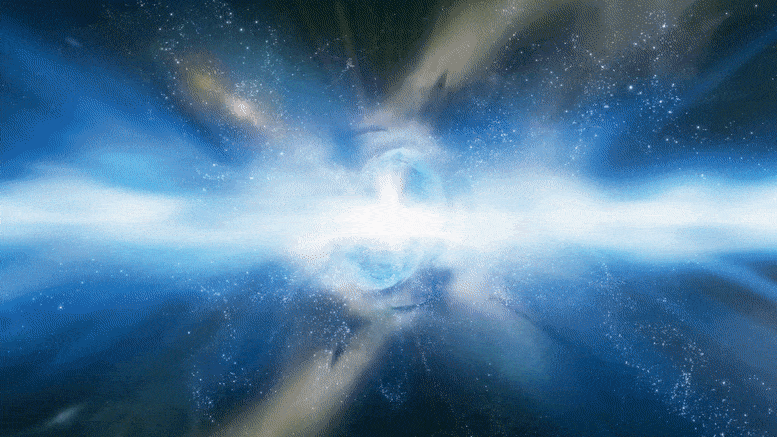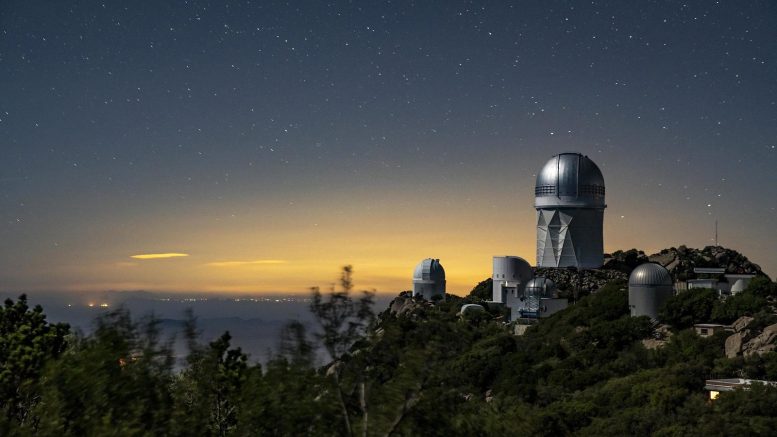
Artist’s illustration of dark energy cosmic expansion concept
What is Cosmic Acceleration and Dark Energy?
The universe is expanding, and it expands a little faster all the time. Scientists call the speeding up of this expansion cosmic acceleration. This growth increases the distance between points in the universe, just like stretching a rubber sheet would make points on that sheet move further and further apart.
The universe has experienced two distinct periods of cosmic acceleration. The first, called inflation, occurred a fraction of a second after the Big Bang. The second is the extended period of cosmic acceleration that began about 9 billion years after the Big Bang and continues today. Scientists discovered the increasing expansion of the universe in 1998 through observations of distant supernovae (exploding stars). The scientists who discovered cosmic acceleration received the 2011 Nobel Prize in Physics.
This discovery posed a new question that scientists continue to explore today: what is the “dark energy” that is overcoming the effect of gravity and pulling our universe apart? Dark energy may be an inherent feature of the universe, or it could be something related to new and unknown particles or forces. It could also be a hint that Einstein’s theory of general relativity is not a complete description of gravity.

The Dark Energy Spectroscopic Instrument at the Mayall Telescope at Kitt Peak National Observatory will use 5,000 robotic “eyes” to map the history of cosmic expansion. Credit: Photo courtesy of Marilyn Chung, Berkeley Lab
Cosmic Acceleration and Dark Energy Quick Facts
- Scientists are conducting studies to determine whether dark energy is consistent with the cosmological constant, a term Albert Einstein originally included in his equations to counterbalance gravity. Alternatively, dark energy may not be constant, but something that changes over the history of the universe.
- Dark energy accounts for about 70% of the total mass-energy of the universe. In contrast, dark matter accounts for about 25% of the universe’s mass-energy, and ordinary matter only 5%.
DOE Office of Science: Contributions to Cosmic Acceleration & Dark Energy
The Department of Energy supports researchers who seek to understand cosmic expansion and dark energy. Scientists supported by DOE partner with the National Science Foundation and other organizations to build specialized, sensitive detectors. Teams of scientists are conducting experiments to measure characteristics of the cosmic microwave background, faint light left over from the hot early universe. Their work may provide clues about the early inflation of the universe. Scientists also use large-scale ground-based telescope surveys to gather data about the past and present universe that will improve our understanding of the universe’s long-term history. These surveys will help shed light on the nature of dark energy.









Another way to explain Dark Energy is suggested by String Theory. All matter and energy, including photons (light), have vibrating strings as their basis.
String and anti-string pairs are speculated to be created in the quantum foam, a roiling energy field suggested by quantum mechanics, and they immediately annihilate each other. If light passes near these string/anti-string annihilations, perhaps some of that annihilation energy is absorbed by the string in the light. Then the Fraunhofer lines in that light will move a bit towards the blue and away from the red shift. As this continues in an expanding universe we get the same curve displayed by Perlmutter and colleagues at their Nobel Prize lecture, without the need for Dark Energy.
This speculation has the universe behaving in a much more direct way. Specifics can be found in my YouTube https://www.youtube.com/watch?v=0b6t0jO7IgQ
Self promotion, of a descoped and evidently dying hypothesis to boot. Also boring, since this is a common posting of yours. Specifically this time, there is no evidence of “quantum foam” and the century old “tired light” idea does not work.
On tired light:
“The concept was first proposed in 1929 by Fritz Zwicky, who suggested that if photons lost energy over time through collisions with other particles in a regular way, the more distant objects would appear redder than more nearby ones. Zwicky himself acknowledged that any sort of scattering of light would blur the images of distant objects more than what is seen. Additionally, the surface brightness of galaxies evolving with time, time dilation of cosmological sources, and a thermal spectrum of the cosmic microwave background have been observed—these effects should not be present if the cosmological redshift was due to any tired light scattering mechanism.”
[“Tired light”, Wikipedia]
On the status of sypersymmetry:
“The idea of a symmetry between fermions and bosons originated in the early 1970s to address a mathematical issue with string theory. In 1974, Julius Wess and Bruno Zumino discovered that a broad class of quantum field theories could be made supersymmetric through a generalization of the symmetries of relativity. Soon researchers devised theories in which a particle and its superpartner could have different masses.
In the early 1980s, theorists realized that the Standard Model itself could be made supersymmetric and that this extension would resolve some vexing problems with the theory.”
“The simplest supersymmetric theories—those that best explain the Higgs boson—predict a zoo of new particles with masses comparable to those of the W and Z bosons. Those were within reach of the Large Hadron Collider, so when it turned on in 2009, many particle physicists thought the discovery of superpartners was imminent. But after the triumphant discovery of the Higgs boson came … no more new fundamental particles.
“I was shocked when supersymmetric particles were not discovered in the early days of the LHC,” Peskin says.
Not all theorists were caught by surprise. “There were many people who were loudly saying that there was something wrong with the basic picture of supersymmetry well before the LHC,” says Nima Arkani-Hamed, a theorist at the Institute for Advanced Study in Princeton, New Jersey. “You would have thought that if all these particles were lying around not much heavier than where we’ve been, they would leave some indirect effects in low-energy physical process.””
“The saga of supersymmetry “should be taken as a caution,” Gates says. “This, unfortunately, is an example where the particle physics community got its head out over its skis. We should always be extraordinarily mindful that nature is indeed subtle, and we have to take our cues from nature.”
As segments of the particle physics community have drifted away from supersymmetry, many experimentalists remain optimistic.”
“Supersymmetry may not solve all the problems that researchers initially hoped it would.”
[ https://www.symmetrymagazine.org/article/the-status-of-supersymmetry ]
By the way, if anyone is interested, there is a potential for the same explanation for the finetuning – small result of subtraction of huge numbers – of the vacuum energy that eBOSS shortlists in the referenced paper and the standard model Higgs mass finetuning that the linked symmetry article describe. Neither of which supersymmetric string theory evidently can explain, but can be explained from known quantum inflation field physics (i.e. from Planck 2018 observation that the inflation is a simplest possible quantum scalar field, analogous to the Higgs field but simpler).
It is perhaps good to note more of the context here, since the research edge on cosmology moves ever on, and this general area while interesting is claimed to be fairly settled.
“Perhaps the simulations’ single biggest lesson so far is not that scientists need to revise their overarching theory of cosmology, but rather that problems lurk in their understanding of astrophysics at smaller scales. In particular, their theory of star formation comes up wanting, Springel says.”
[“Galaxy simulations are at last matching reality—and producing surprising insights into cosmic evolution”, Science, 2018]
Specifically here, while there is a last remaining tension in the cosmic expansion rate that fix the acceleration in expansion, dark energy is ever more consistent with the expected vacuum energy of the quantum particle fields.
“Nevertheless, the observed consistency with flat ΛCDM at the higher precision of this work points increasingly towards a pure cosmological constant solution, for example, as would be produced by a vacuum energy finetuned to have a small value.”
[“THE COMPLETED SDSS-IV EXTENDED BARYON OSCILLATION SPECTROSCOPIC SURVEY: COSMOLOGICAL IMPLICATIONS FROM TWO DECADES OF SPECTROSCOPIC SURVEYS AT THE APACHE POINT OBSERVATORY”, arxiv 2007.08991, 2020]
Another change implied by astrophysicist sources is that the article description of “inflation [that] occurred a fraction of a second after the Big Bang” is itself under (likely generation shift) replacement since it is ironically considered less settled.
“I call [time of inflation events] “before the big bang” because many physicists are moving away from the picture where you have the big bang, then you have an instant of inflation, then regular expansion. For example, in the eternal inflation model, inflation may have lasted for a very very long time and may still be continuing almost everywhere …” [“Does Time Cause Gravity?”, PBS Space Time, 2021, my youtube transcript, ~9:50 in].
“Inflation came first, and its end heralded the arrival of the Big Bang. There are still those who disagree, but they’re now nearly a full 40 years out of date. ”
[“What Came First: Inflation Or The Big Bang?”, Forbes, 2019]
Dark energy is the outflow of dark matter along the pole of our universe’s hypermassive black hole.
Bot speak? No.
How is cosmic expansion ,accelaration and dark energy all related ? It is inertia . The universe is spinning.
We can see in the cosmic background that it is not. The universe is isotropic.
Besides, you can only have either expansion or rotation, not both [ https://en.wikipedia.org/wiki/G%C3%B6del_metric ].
I like all the comments here. Along time ago in human years I made the comment that the great flow of the universe must have an origin and a start point from which the universe grew. What I meant was it appeared to me that oh wait I will try and explain it like this. So take all the water out of the Pacific Ocean ok. Now you have a garden hose and water is flowing but instead of the ocean think empty universe and the garden hose is something else. Ok so the garden hose instead of lying on the edge of the ocean it gets thrust through the center and the waters flowing it’s got along way to go to fill the ocean but after along long time we see the water but we can’t see where it’s coming from we know it’s there but so much waters been put in said ocean that we don’t know where it’s coming from as the size or mass has got to a point where the origin has been lost we know it’s still flowing but the oceans so big now we can never see where it started. We know it’s still flowing we just can’t find the source because there’s just to much water(space@matter) and ocean to see back to the start.
No. We can see in the cosmic background that there is no privileged starting point. The universe is homogeneous and isotropic. It is also expanding homogeneously and isotropically everywhere.
Now that explanation does make a lot of sense and helps with lots of problems. Now dark energy could be that or could be that humm I was telling y’all about which is created from the permissive blacksphere’s at the centers of all galaxies. The radiation that’s permiating the universe comes from them and all the stars you can’t have that much energy without something happening like dark energy of the great flow which keeps the universe ALIVE and moving. Thanks for reading have a great day.